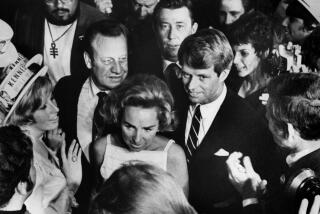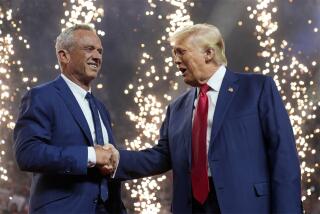Obama has overstated Kennedys’ aid to his dad
- Share via
WASHINGTON — Addressing civil rights activists in Selma, Ala., a year ago, Sen. Barack Obama traced his “very existence” to the generosity of the Kennedy family, which he said paid for his Kenyan father to travel to America on a student scholarship and thus meet his Kansan mother.
The Camelot connection has become part of the mythology surrounding Obama’s bid for the Democratic presidential nomination. It is a touching story -- but key details are either untrue or grossly oversimplified.
Contrary to references by Obama in speeches in January at American University and in Selma last year, the Kennedy family did not provide the funding for a September 1959 airlift of 81 Kenyan students to the United States that included Obama’s father.
According to historical records and interviews with participants, the Kennedys were first approached for support for the program nearly a year later, in July 1960. The family responded with a $100,000 donation, most of which went to pay for a second airlift in September 1960.
Obama spokesman Bill Burton acknowledged Saturday that the senator from Illinois had erred in crediting the Kennedy family with a role in his father’s arrival in the United States. He said the Kennedy involvement in the Kenya student program apparently “started 48 years ago, not 49 years ago as Obama has mistakenly suggested in the past.”
The real story of Barack Obama Sr.’s arrival in the United States and the subsequent Kennedy involvement in the airlifts of African students sheds light on the highly competitive presidential election of 1960 and Africa’s struggle to free itself from colonialism, as well as the huge strides made by the Obama family.
A more accurate version would begin not with the Kennedys but with a Kenyan nationalist leader named Tom Mboya, who traveled to the United States in 1959 and 1960 to gain support for his efforts to educate a new African elite.
Mboya, a charismatic politician, was assassinated in 1969. His daughter Susan, now living in Ohio, said the mass airlifts of Kenyan students to the United States had a “huge” impact on the young African nation, which gained its independence from Britain in 1963. She cited a University of Nairobi study that showed that 70% of top Kenyan officials after independence were products of the American program.
In the late 1950s, there was no university in Kenya, and educational opportunities for Africans were limited. The British colonial government opposed Mboya’s efforts to send talented young Kenyans to the United States for an education, arguing that there was a perfectly good university, Makerere College, in neighboring Uganda. The U.S. State Department supported the British and turned down Mboya’s requests for assistance.
During his 1959 trip to the United States, the 29-year-old Mboya raised enough money for scholarships for 81 young Kenyans, including Obama Sr., with the help of the African-American Students Foundation. Records show contributions from almost 8,000 individuals, including baseball star Jackie Robinson, who gave $4,000, and actors Harry Belafonte and Sidney Poitier.
There was enormous excitement when the Britannia Airways flight took off for New York. After a few weeks of orientation, the students were dispatched to universities across the United States to study subjects that would help them govern Kenya after the departure of the British. Obama Sr. was interested in economics and was sent to Hawaii, where he met, and later married, Kansas native Ann Dunham. Barack Jr. was born in August 1961.
Mboya decided to expand the program in 1960 and to include students from neighboring African countries. This time, he raised $250,000 for 256 students. Universities and colleges promised scholarships worth $1.6 million, but Mboya still needed money for the airlift itself.
His American friends suggested that he approach Sen. John F. Kennedy, who had just launched a presidential campaign. In addition to chairing a Senate subcommittee on Africa, Kennedy controlled the Joseph P. Kennedy Jr. Foundation, named after his older brother, who was killed in World War II.
The two men met at the Kennedy compound at Hyannis Port, Mass., on July 26, 1960. Kennedy later said that the family was initially “reluctant” to support the program because of other commitments but eventually agreed to provide $100,000.
Vice President Richard M. Nixon, determined not to be outdone by his Democratic rival for the White House, persuaded the State Department to drop its long-standing refusal to fund the program.
The former executive director of the African-American Students Foundation, Cora Weiss, said some of the money provided by the Kennedys was used to pay off old debts and subsidize student stipends. Even though Obama Sr. arrived the previous year, he and other members of the 1959 airlift benefited indirectly from Kennedy family support.
More to Read
Sign up for Essential California
The most important California stories and recommendations in your inbox every morning.
You may occasionally receive promotional content from the Los Angeles Times.











